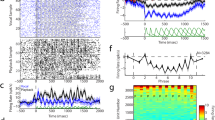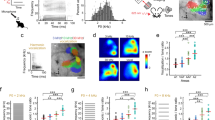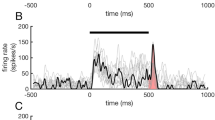Abstract
Speaking and singing present the auditory system of the caller with two fundamental problems: discriminating between self-generated and external auditory signals and preventing desensitization. In humans1 and many other vertebrates2,3,4,5,6,7, auditory neurons in the brain are inhibited during vocalization but little is known about the nature of the inhibition. Here we show, using intracellular recordings of auditory neurons in the singing cricket, that presynaptic inhibition of auditory afferents and postsynaptic inhibition of an identified auditory interneuron occur in phase with the song pattern. Presynaptic and postsynaptic inhibition persist in a fictively singing, isolated cricket central nervous system and are therefore the result of a corollary discharge from the singing motor network. Mimicking inhibition in the interneuron by injecting hyperpolarizing current suppresses its spiking response to a 100-dB sound pressure level (SPL) acoustic stimulus and maintains its response to subsequent, quieter stimuli. Inhibition by the corollary discharge reduces the neural response to self-generated sound and protects the cricket's auditory pathway from self-induced desensitization.
This is a preview of subscription content, access via your institution
Access options
Subscribe to this journal
Receive 51 print issues and online access
$199.00 per year
only $3.90 per issue
Buy this article
- Purchase on Springer Link
- Instant access to full article PDF
Prices may be subject to local taxes which are calculated during checkout




Similar content being viewed by others
References
Creutzfeldt, O., Ojemann, G. & Lettich, E. Neuronal activity in the human temporal lobe II. Responses to the subjects own voice. Exp. Brain Res. 77, 476–489 (1989)
Suga, N. & Schlegel, P. Neural attenuation of responses to emitted sounds in echolocating bats. Science 177, 82–84 (1972)
Suga, N. & Shimozawa, T. Site of neural attenuation of responses to self-vocalized sounds in echolocating bats. Science 183, 1211–1213 (1974)
Schuller, G. Vocalization influences auditory processing in collicular neurons of the CF-FM bat, Rhinolophus ferrumequinum. J. Comp. Physiol. A 132, 39–46 (1979)
McCasland, J. S. & Konishi, M. Interaction between auditory and motor activities in an avian song control nucleus. Proc. Natl Acad. Sci. USA 78, 7815–7819 (1981)
Müller-Preuss, P. & Ploog, D. Inhibition of auditory cortical neurons during phonation. Brain Res. 215, 61–76 (1981)
Metzner, W. A possible neuronal basis for Doppler-shift compensation in echo-locating horseshoe bats. Nature 341, 529–532 (1989)
Nocke, H. Physiological aspects of sound communication in crickets (Gryllus campestris L.). J. Comp. Physiol. A 80, 141–162 (1972)
Michel, K. Das Tympanalorgan von Gryllus bimaculatus DeGeer (Saltatoria, Gryllidae). Z. Morph. Tiere 77, 285–315 (1974)
Schildberger, K., Wohlers, D. W. & Huber, F. in Cricket Behaviour and Neurobiology (eds Huber, F., Moore, T. E. & Loher, T. E.) 423–458 (Cornell Univ. Press, Ithaca/London, 1989)
Jones, M. D. R. & Dambach, M. Response to sound in crickets without tympanal organs (Gryllus campestris L.). J. Comp. Physiol. A 87, 89–98 (1973)
Suga, N. & Jen, P. Peripheral control of acoustic signals in the auditory system of echolocating bats. J. Exp. Biol. 62, 277–311 (1975)
Borg, E. & Counter, S. The middle-ear muscles. Sci. Am. 261 (August), 62–68 (1989)
Narins, P. M. Reduction of tympanic membrane displacement during vocalization of the arboreal tree frog, Eleutherodactylus coqui. J. Acoust. Soc. Am. 91, 3551–3557 (1992)
Hennig, R. M. et al. Auditory threshold change in singing cicadas. J. Exp. Biol. 187, 45–55 (1994)
Poulet, J. F. A. & Hedwig, B. Tympanic membrane oscillations and auditory receptor activity in the stridulating cricket Gryllus bimaculatus. J. Exp. Biol. 204, 1281–1293 (2001)
Clarac, F. & Cattaert, D. Invertebrate presynaptic inhibition and motor control. Exp. Brain Res. 112, 163–180 (1996)
Hardt, M. & Watson, A. H. D. Distribution of input and output synapses on the central branches of bushcricket and cricket auditory afferent neurones: immunocytochemical evidence for GABA and glutamate in different populations of presynaptic boutons. J. Comp. Neurol. 403, 281–294 (1999)
Pollack, G. S. Selective attention in an insect auditory neuron. J. Neurosci. 8, 2635–2639 (1988)
Sobel, E. C. & Tank, D. W. In vivo Ca2+ dynamics in a cricket auditory neuron: an example of chemical computation. Science 263, 823–826 (1994)
Givois, V. & Pollack, G. S. Sensory habituation of auditory receptor neurons: implications for sound localization. J. Exp. Biol. 203, 2529–2537 (2000)
von Holst, E. & Mittelstaedt, H. Das reafferenzprinzip. (Wechselwirkungen zwischen zentralnervensystem und peripherie.). Naturwissenschaften 37, 464–476 (1950)
Sperry, R. W. Neural basis of the spontaneous optokinetic response produced by visual inversion. J. Comp. Physiol. Psych. 43, 482–489 (1950)
Zaretsky, M. & Rowell, C. H. F. Saccadic suppression by corollary discharge in the locust. Nature 280, 583–585 (1979)
Bell, C. C. An efference copy which is modified by reafferent input. Science 214, 450–453 (1981)
Guthrie, B. L., Porter, J. D. & Sparks, D. L. Corollary discharge provides accurate eye position information to the oculomotor system. Science 221, 1193–1195 (1983)
Sillar, K. T. & Roberts, A. A neuronal mechanism for sensory gating during locomotion in a vertebrate. Nature 331, 262–265 (1988)
Bell, C. C. in Comparative Physiology of Sensory Systems (eds Bolis, L., Keynes, R. D. & Maddrell, S. H. P.) 636–647 (Cambridge Univ. Press, Cambridge, 1984)
Hedwig, B. Control of cricket stridulation by a command neuron: efficacy depends on the behavioural state. J. Neurophysiol. 83, 712–722 (2000)
Knepper, M. & Hedwig, B. NEUROLAB, a PC-program for the processing of neurobiological data. Comp. Methods Programs Biomed. 52, 75–77 (1997)
Acknowledgements
We thank M. Burrows, T. Matheson and S. Rogers for comments on the manuscript. This work was supported by a Biotechnology and Biological Sciences Research Council (BBSRC) studentship and grants from the Wellcome Trust and the Royal Society.
Author information
Authors and Affiliations
Corresponding author
Ethics declarations
Competing interests
The authors declare that they have no competing financial interests.
Rights and permissions
About this article
Cite this article
Poulet, J., Hedwig, B. A corollary discharge maintains auditory sensitivity during sound production. Nature 418, 872–876 (2002). https://doi.org/10.1038/nature00919
Received:
Accepted:
Issue Date:
DOI: https://doi.org/10.1038/nature00919
This article is cited by
-
Accommodating unobservability to control flight attitude with optic flow
Nature (2022)
-
Self-generation and sound intensity interactively modulate perceptual bias, but not perceptual sensitivity
Scientific Reports (2021)
-
Sensorimotor Integration Can Enhance Auditory Perception
Scientific Reports (2020)
-
Motor flexibility in insects: adaptive coordination of limbs in locomotion and near-range exploration
Behavioral Ecology and Sociobiology (2018)
-
A cerebellum-like circuit in the auditory system cancels responses to self-generated sounds
Nature Neuroscience (2017)
Comments
By submitting a comment you agree to abide by our Terms and Community Guidelines. If you find something abusive or that does not comply with our terms or guidelines please flag it as inappropriate.



